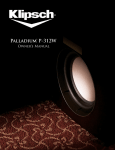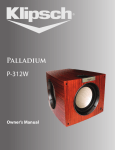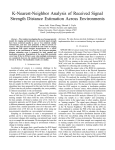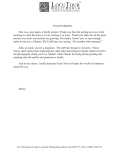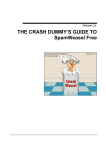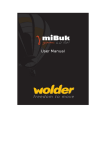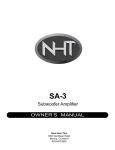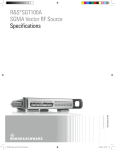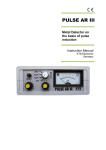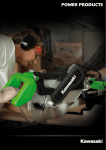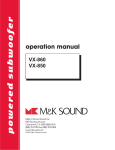Download ROSEBUD OWNERS MANUAL
Transcript
RUSHMORE OWNERS MANUAL Revision 0.3 May 13, 2004 INTRODUCTION Pass Labs is pleased to introduce the “Rushmore” loudspeaker system, the first loudspeaker designed as a commercial offering for Pass Labs by legendary analog designer Nelson Pass. The “Rushmore” represents 30 years of gestation and over three years of intensive development, revision and thoughtful listening by Nelson Pass and the staff at Pass Labs. This is an exceptionally dynamic and tonally balanced active four-way listening system featuring a 15 inch woofer, 10 inch lower midrange, 6 inch upper midrange and a 4 inch ribbon tweeter. Fit, finish and build quality is exceptional, and like all Pass Labs product it represents the labor of a few very dedicated technicians and talented craftspeople. We believe this to be the most sonically and technologically advanced listening system available to the consumer today. We also believe the “Rushmore” loudspeaker system makes sense for today’s lifestyle choices and conveys a tangible and palpable value to the high-end audio experience. This loudspeaker system minimizes your hardware and cabling concerns thus allowing you to concentrate on the delightful sonic experience of instrument and voice. The “Rushmore” is a very sophisticated and complete system that invites you to look past the technology, and feel entertained both visually and auditorially. This unique listening system contains four independent purpose-built low wattage amplification packages plus a Nelson Pass designed four-way active electronic crossover within each loudspeaker. Each driver receives amplification from it’s own carefully tailored amplifier using Pass Labs proprietary circuit topologies. Each amplifier has performance characteristics, which have been optimized to best suit the assigned driver. Three 10 watt single ended Class A amplifiers power the two midrange and top end driver, and a 40 watt Aleph-X Super-Symmetric amplifier is dedicated to powering the woofer. The careful integration of high efficiency speaker drivers and four low wattage class A amplifiers has given practicality to a full range “Class A” driven loudspeaker, unique in the ability to deliver approximately 120 dB of exceptionally wide bandwidth acoustic energy at low levels of acoustic distortion. No longer is the sonic magic of “Class A” restricted to powering your favorite tweeter. “Rushmore” brings this amplifier magic to a dynamic nine-octave loudspeaker system. PHILOSOPHY The mantra of Nelson Pass and Pass Labs in the design of “Rushmore” has been the Zen-like pathway of “Synergy and Harmony”. Nelson started this particular design by speculating what 1 characteristics a loudspeaker would posses if the production values of product now revered as priceless classics from the golden age of audio were still in vogue. Pass Labs procured every speaker driver available that even remotely looked like it held promise of inclusion into the “Rushmore” project. Special emphasis was given to locating speaker drivers which excel at articulating infinitesimal details and have a warm, spacious, easy character. Prospective drivers were sourced from both the professional and consumer market, ultimately only paper cones and ribbons would be chosen. Although much attention was lavished on horns, domes and alternative materials none had the sonic character we desired. Each driver underwent thorough evaluation and numerous test enclosures until it’s full potential was realized and documented. Drivers were then evaluated in conjunction; seeking those special combinations that mutually complemented one another resulting in a refined top to bottom balanced presentation of sound. Evaluation of individual components has been a thorough and a thoughtful application of technology and taste, the eventual mate of the individual pieces we believe represents a collective far greater than the sum of the selected parts. To achieve this exquisite synergy the passions of an audiophile and lover of live music have been carefully weighed against the thoughts and experience of a brilliant analog designer. Nelson’s years of serious listening and patented groundbreaking designs give credence to the audiophile perception that not all products which measure well convey the magic and romance that the recording engineer and artist hope to capture. “Rushmore” bridges the gap between product with spectacular performance and product with stellar specifications. ELECTRONICS The precise matching of the four high efficiency loudspeaker drivers and the four independent channels of amplification has been significantly enhanced and refined by the four channels of Rushmore’s internal active crossover. Inclusion of the Nelson Pass designed active line level crossovers have allowed “Rushmore” to overcome the non linearity and high distortion products inherent in the technology utilized by other manufacturers in virtually every passive crossover ever produced. Foregoing the frailties of passive crossovers in favor of active crossovers, quad amping and very high efficiency drivers makes Rushmore a very different listening experience. For the listener this translates to a more refined spatial sound stage, increased awareness of micro-detail and overall greater approximation of sonic reality. “Rushmore” invites and conveys musicality even when listening outside of the ideal focal spot. With multi channel formats, listening at the central point of focus is always preferred, but unlike some products, “Rushmore” does not demand this; freeing you to listen to “Rushmore” casually as well as seriously. This ability to convey music outside of a very narrow listening field was a Pass Labs acceptance criterion for this product, because we believe that music should be an integral part of your life, rather than an exercise in sedentary isolation. Rushmore successfully banishes the necessity of listening critically from one rigidly defined sweet spot, letting music fill the entire room. 2 The high efficiency woofer and midranges in this all-new listening system operate with phasecoherent single-pole crossover characteristics to beyond 6 kHz, and there is a single-pole equalization curve applied on the extreme bottom end of the woofer. To optimize Rushmore’s versatility individual amplifiers are provided with sufficient level trimming to tailor Rushmore’s in room response to best suit your listening environment. To allow the greatest freedom in choice of source components, and control electronics; inputs to “Rushmore” are provided for either single ended or balanced sources, and input impedance have been made compatible with either solid state or tube source electronics. “Rushmore” has been made user and auxiliary equipment friendly by inclusion of trigger circuits that allows it to be controlled by other home entertainment electronics. The gated Fast Fourier response curve of this listening system is truly outstanding, with a usable frequency response from approximately 20Hz to 40kHz. Each of the four drivers has a measured sensitivity of nearly 100 dB referenced to 1 Watt at 1 Meter. This above normal sensitivity gives the “Rushmore” system superb expression of micro and macro dynamics. Within “Rushmore” there is sufficient Single-ended “Class A” amplification to routinely achieve 120 dB peaks with negligible acoustic distortion. The high sensitivity of this system offers low level resolution previously enjoyed only by those people fortunate enough to have experienced the very finest horn systems. Retrieval of transient detail by “Rushmore” rivals that of legendary electrostatic systems. Characteristically unlike either horn or electrostatic the “Rushmore” is tolerant and adaptable; allowing it to integrate into rooms rather than dominating and strictly dictating placement of itself, the listener and everything else within the listening environment. “Rushmore” strives to be a very different audiophile experience and to the greatest extent possible fits your world rather than requiring that you adapt your world to complement its acoustic behavior. MECHANICAL The infinite baffle enclosure for this system is structurally stabilized and visually enhanced by a massive four foot high heat sink at the rear of the speaker, elegantly curved and rendered wood sides and beautifully machined and polished stone tops, bottoms and fronts. Each piece is a product of “Old World” construction values that invites tactile exploration and is a delight to the eye. For many years the material of choice for loudspeaker enclosures has been an engineered wood material known as MDF (medium density fiberboard); MDF has some real engineering advantages for speakers, not the least of which is it’s exceptionally low cost and ease of machining. At Pass Labs we felt that there had to be a better way to achieve the mechanical advantages of MDF in a more durable and aesthetically pleasing material. To achieve this we acquired the services of craftspeople versed in the art of piano manufacturing to teach us the century old techniques of constructing concert grand pianos, we then applied that highly refined craft to speaker building. We believe the magic of this type of construction is valid for speaker cabinets for the very same reasons that it is valued as the only accepted choice for constructing fine musical instruments. These techniques and materials require a very labor-intensive approach to construction, which we believe is truly justified by this product. The curved wood side-panels are meticulous formed from many thin layers of engineering grade apple wood, alder and spruce glued to each other under heat and pressure. The visual layer is 3 cherry, each piece chosen for a combination of attractive color and grain. To surpass the resonance damping qualities of MDF we bond the engineering ply to materials with significantly different physical properties. For this task we chose highly polished stonework and anodized aluminum. The tops bottoms and fronts of “Rushmore” are constructed of quarried Amphibolite. This granitelike stone has its origins in deep ocean earth crust where it has been subjected to millenniums of tremendous pressure and very slow cooling from the molten state. Under the influence of nature’s forces this quarried material has evolved with great beauty and considerable stability. Bonding of stone and wood have created a beautiful structure that addresses the needs of form and function. We take pride in presenting a product that showcases natural materials in their most complementary form and in a way that serves our engineering requirements synergistically. Materials are closely matched into sets, but we believe that part of the charm of “Rushmore” comes from the subtle uniqueness inherent to these natural materials. Cherry in particular is a fascinating dynamic material, it’s color and character continually respond to changes in light, for this reason it has long been coveted as a material for fine furniture. This product has been art-engineered to elegantly enhance your décor, the “Rushmore” will become a visual and sonic focal point in your home or studio that you will delight in auditioning and displaying. Each speaker weighs approximately 250 lbs., and measures approximately 50 inches high, 18 inches wide and 28 inches deep. UNPACKING Due to the unusual mass of these loudspeakers, we urge you to follow our instructions for unpacking and positioning. Not only does the possibility exist for damaging the speaker finish, it is also quite possible that mishandling could result in damage to your health, architecture and domestic tranquility. We have given considerable thought to engineering the packing of these speakers, anticipating that you use the built in features of the shipping containers as an aid to unpacking and setup. Please consult the enclosed diagrams, relax, enjoy yourself and enlist help. This product is extremely heavy and will require more than one person to unpack and position it safely. These loudspeakers must be moved by appliances and supported by structures that were designed with these loads in mind. When moving and unpacking Rushmore, we recommend you wear sturdy closed toe shoes to help avoid personal injury in case of accident. Please observe the normal rules of good posture when lifting heavy objects to avoid strain. Remove any rings and bracelets to avoid damage to the surfaces of the product. Don’t unpack this product alone, enlist help; find two sturdy people. Better yet, get your dealer to do it for you. Study the description and drawings carefully before attempting this task. Have a plan and make sure everyone helping knows what that plan requires of them. 4 1) Remove the outer box banding and top cover. 2) Remove the top poly-foam tray. 3) Remove the outer box by lifting upward and to the side. This requires that you have at least 8foot (2.4 meter) high ceilings. If your overhead clearance is less you must reposition the speakers into a more hospitable space for unpacking. 4) This step requires that there be approximately 6 feet (2 meters) of unobstructed floor space behind the speaker. In order to remove the bottom poly-foam tray you will need to carefully lay the speaker on its back surface. This step absolutely requires more than one person. The top tray is to be used as a protective cushion between the rear mounted heatsink and the floor. Start by placing the top tray directly behind “Rushmore”. Two or more people should then carefully tilt the speaker to the rear and lay it on it’s rear surface. In this position, the speaker will not be stable and must be stabilized by at least on person. At this point the bottom tray may be removed. 5) Place the “Rushmore” speaker in an upright orientation. This is best accomplished with two people lifting. If this is being done on a non-carpeted surface, take special care neither speaker or persons slip and fall. 6) Remove the central poly-foam collar 7) Remove the plastic shrink-wrap. CAUTION: Stray magnetic fields The speaker drive units create stray magnetic fields that extend beyond the boundaries of the cabinet. We recommend you keep magnetically sensitive articles (television and computer screens, computer discs, audio and video tapes, credit cards and the like) at least 0.5m from this speaker. Looking at the rear panel of the unit you will see the AC Power cord receptacle, a power switch, fuse holder, two input connectors, a stand-by switch, remote control trigger and four level controls. The Rushmore is connected to the user’s electrical supply through a provided standard power cord. This power cord fits into the IEC line receptacle at the lower left of the speakers rear surface. Rushmore is equipped for operation with an earth ground, which is provided by the user’s AC outlet. Never defeat this ground, its use will not adversely affect the performance of this product. The chassis and circuit ground of the internal electronics are connected to earth through a power thermistor, which gives a ground connection for safety but helps avoid troublesome ground loops. You may substitute your favorite IEC 15 amp power cord for the supplied one, but please make sure it is approved by all the local authorities and does not defeat the safety ground. Directly above the IEC power connection is a line voltage fuse holder. The current and voltage are indicated on the rear of the unit. It will be either 240 volts, 220 volts, 120 volts or 100 volts. A 2amp 3AG fuse is provided for 240 and 220 volts operation. A 4-amp 3AG slow blow fuse is provided for 120 or 120 volt operation. The input frequency rating of the power supply in all cases is 50 to 60 Hz. The Rushmore typically draws less than 600 watts during normal operation. To the left of the IEC connector (when viewed from the rear) is the main power switch for “Rushmore’s” internal crossover and amplification. To the left of the power switch is a pair of fiveway binding posts for remote control trigger. Switching the main power switch to the on position 5 applies power to the internal electronics and illuminates the main power LED which is located on the upper surface of the rear mounted heatsink directly above the input connectors. At the top of the rear-mounted heatsink on the left side you will see a row of four speaker level control potentiometers, one for each loudspeaker driver. Turning any one of these pots to the right (clockwise) will increase the output level of that driver. Turning any one of these pots to the left (counter-clockwise) will decrease the output level of that driver. At the top of the rear mounted heatsink on the right side you will see the standby / auto / on switch. When in the standby position it allows Rushmore to be controlled by the on/off function of our X series pre-amplifiers and other products which provide a 12 volt trigger. In the auto position an audio input applied to either the single ended or balanced input will turn the internal amplification of the Rushmore Loudspeaker immediately to on. In the absence of signal this same circuit will turn the Rushmore Loudspeaker electronics to “sleep” in approximately ½ hour. The on position of this switch is self-explanatory. Below the standby / auto / on switch you will see the two input connectors. Balanced input will always occur through the XLR connector, which is the uppermost of the two. Unbalanced input will always occur through the RCA connector, which is located directly below the XLR connector. The amplifiers within Rushmore may be driven single ended or balanced, if driving the electronics single ended leave the supplied jumper in place (between pins 1 & 3 on the XLR connector). Leaving the jumper out will not damage the circuit, but it will diminish the sonic excellence of this product. If you are driving the electronics balanced pin 1 on the XLR is ground, pin 2 is the normal input and pin 3 is the inverted input. SETUP As with all loudspeakers, you must to some extent regard the listening room as an extension of the speaker. The acoustic character of the room will have a profound effect on the final sound quality. To the greatest extent possible, Pass Labs has designed the “Rushmore” to be exceptionally room independent. Within “Rushmore’s” four way active electronics we have provided + / - 3dB of level trimming for each of the four individual driving elements via rear panel potentiometers. Full clockwise rotation of any one of the four potentiometers gives a 3 dB boost in signal to its respective driver and conversely full counter-clockwise gives 3 dB of attenuation to that driver’s acoustic output. There is the tendency within the audio community to feel uncomfortable with controls that are set at one physical extreme or the other. To get the best out of “Rushmore” you must disregard this prejudice. We intended the full range of controls available to the user to be useable control. Performance both acoustically and electrically will not degrade anywhere within the controls available adjustment range, use them with confidence. In general we recommend that speakers and listener be set up at the vertices of an imaginary equilateral triangle. This is the geometry frequently used in the recording studio to position the microphones and the voice in vocal tracks for a great majority of popular recordings. Recreating this geometry with speakers and listener generally does an excellent job of recreating the “studio sound”. 6 With this equilateral triangle placement format the listener will be as far away from each speaker as the speakers are from each other. For best stereo imaging, the speakers should be no closer to one another than 2 meters (6 ½ feet) and we see little reason to have them much more than 4 meters (13 feet) apart. Some rooms may require greater separation, or a different listening position, but not to worry; this too can be accommodated with the operational controls. The most likely domestic scenario is that room décor will necessitate the listener sitting farther back from Rushmore than would be indicated by the equilateral triangle formula. This may cause a slightly brighter presentation of the audio spectrum, necessitating an adjustment of the mid range or tweeter levels to compensate for this overly forward presentation. If the speakers are to be placed further apart than indicated this could cause a slight dulling of the audio spectrum. This dulling can in most case be ameliorated by increasing the gain on the high frequency drivers or by subtly reducing the output of the woofer and perhaps mid woofer. In some cases the speaker cabinets may need to be angled so they point more directly toward the listening spot. Angling the speakers toward one another can also assist in preserving a stereo image “center fill” when speakers are otherwise too far apart to achieve this desirable effect. Classic acoustic knowledge teaches us that with the exception of some horn systems, loudspeakers rarely sound best when placed close to a wall or corner. When placed close to walls, the walls become very efficient acoustic reflectors and contribute significantly to the sonic signature of any loudspeaker. For loudspeakers that are bass (low frequency) impaired being in a corner can be of some benefit; the “Rushmore” is not that kind of product. Each frequency has it’s own characteristic wavelength, therefore you can logically expect that proximity to a large structure will affect specific frequency ranges more strongly than others. If given a choice the distance from loudspeaker to side wall and loudspeaker to back wall should be dissimilar so as to minimize room interaction at any particular frequency. Small variations in speaker placement often pay huge dividends acoustically. Some listeners will have requirements that dictate a corner placement of one or more of their loudspeakers. Corner placement has the strongest effect on low frequency balance, feel free to experiment with rear panel level controls to get the best top to bottom balance of frequency. The ideal seating height places the listeners ears approximately 39 inches (1 meter) above floor level. A lower seating level may require readjustment of the level controls to achieve a neutral spectral balance of the Rushmore. A seating height that places the listeners ears on level equal to the tweeter height or above tweeter height is not encouraged. Keep in mind that “Rushmore” was designed to fit your lifestyle and environment and as such offers great opportunity for the user to apply minor adjustments that correct for less than ideal acoustics or speaker placement. Minor adjustments in speaker position and level controls can achieve significant gains in overall frequency balance. Taking the time to optimize electrical settings and physical location will enhance your listening pleasure significantly. Most listening rooms are not truly symmetrical in their frequency response; Rushmore gives you the opportunity to tailor each speaker independently for the smoothest in room response. 7 Now that you have your loudspeakers in approximately the correct location, turn the main switch to the off position and the standby / on switch to “standby”. You may now attach the power cord to the loudspeaker and then to the mains. Then turn the main power switch to “on”, the blue “power” LED will illuminate. The lights to the house may blink when the power supply charges the capacitors; relax, this is normal. OK, the loudspeaker is sitting there in stand-by mode, you can go ahead and connect the source component either single ended or balanced, but not both. If you are using the RCA connector, make sure the supplied jumper is in place between pins 1 and 3 of the XLR connector. Now that the source component is connected make sure that there is no signal coming from it, probably by reducing to volume to the minimum setting. Just a few quick comments on interconnect cables. We have tried a lot of product and most seem to work quite well. The electronics in “Rushmore” have been designed so that they are not particularly sensitive to interconnect choices. The majority of bad cables we have heard have been more of a function of cleanliness and inadequate contact pressure than engineering or material issues. Rushmore is also not sensitive to radio frequency pick-up but as a rule you should only use shielded interconnect cable with this product. Interconnects even those of the shielded variety should be physically separated from power lines, to minimize electrical noise in your loudspeakers. Balanced cables and connectors are usually preferred, as they tend to provide superior noise rejection and enhanced performance. Pass Labs preamplifiers are optimized with twin identical gain paths for each channel to provide a true balanced output. Not all products with balanced outputs are capable of providing “Rushmore” with a true balanced signal source. For sources components that are unable to provide a true balanced output, you may need to experiment and try both balanced and unbalanced interconnect styles. You can remote control the standby mode by applying a nominal 12 volts DC to the single pair of 5 way binding posts at the lower right of the rear mounted heatsink. The positive of the 12-volt DC signal goes to the red binding post, negative to the black. This trigger will override the heatsink mounted standby switch; so, if you want the switch to operate manually leave the connections to these binding posts open. This feature was designed to function with the Pass Labs remote control family of pre-amplifiers. Our trigger feature may integrate with product other than our own, but we by no means maintain a comprehensive list of other manufacturers compatible features. If you have questions about compatibility your service technician or dealer is an excellent resource for information. For now let’s just ignore the remote trigger and leave it disconnected. You are ready to play music! You have the source volume turned down, interconnects in place, speakers powered up? Take a moment to observe the ribbon tweeter, if the “Rushmore” is powered up and switched on there will be a faint blue illumination within the ribbon aperture. (Purely as a point of humor this blue glow is from the Cherenkov Effect, named after its discoverer Pavel Cherenkov. This particular phenomenon has often been described as the optical equivalent of a sonic boom, an analogy that we find particularly entertaining in this application.) Move the standby / auto / on switch from “standby” to “on” and advance the volume control on your source component to a comfortable listening level. Rushmore has an approximate input sensitivity of 104 8 dBv, 2.0 volts of input will drive the speaker to around 110 dB. Maximum acoustic output is approximately 120 dB (measured at 1 meter). It’s always possible that something could go wrong. If so, don’t get excited, just relax. It’s really aggravating when something like this doesn’t work. We understand the frustration and don’t want you to be without your music; it will get fixed. We take considerable care to make sure product is reliable, and experience a very low equipment failure rate. This is small comfort to the very few, but take it easy and give us a call if you experience problems. People are interested in how long it takes this product to break in. We find it takes about an hour for the electronics to fully warm up and sound their best. Our test environment is about 23 degrees Centigrade, a comfortable room temperature. With time the heatsinks usually rise 27 degrees C. above that for an operational heat sink temperature of 50 degrees C. In your setup the temperature may vary a bit due to your prevailing ambient temperature, line voltage and ventilation, but it is not something to be concerned about. If you can place your hands on the heatsink, temperature is within reason. The electronics have a thermal cutout that disconnects the AC power if the temperature exceeds 75 degrees Centigrade. In real life this cut out device should never actuate. The loudspeaker drivers themselves will require a certain amount of exercise to break-in their suspensions. The greatest change happens within the first 24 hours of play and they tend to settle down within the first one hundred hours of use. There is no magic to breaking in these speakers, just play them as you normally would and expect them to sound more refined with passage of time. FINE TUNING THE POSITION OF THE SPEAKERS If you have the latitude to place the speakers and listening position anywhere within a room, consider the following information. A room’s acoustic character ideally should be considered another component in the play back chain. In reality an excellent acoustic space can make an otherwise modest system perform at a much higher level. Conversely a poor acoustic space can make the finest playback system sound lifeless and uninteresting. Of all the techniques available to acoustic engineers proper speaker placement is one of the most powerful and easily achieved acoustical room treatments available. Music is a complex and yet delicate experience of the senses and the human hearing apparatus is in many ways more complex than we might think. Therefore it is prudent to do all we reasonably can to make the acoustic space in which we listen complementary to that experience. Acoustical “rule of thumb” states that for smoothest bass response, the loudspeaker should be placed 1/3 (or 1/5) the way into the room and the listener should be 2/3 of the way into the room. Both of these positions reduce the apparent effects of standing waves. Successful mitigation of standing waves at the listening position is one of the acoustic “Holy Grails” for realistic sound reproduction. Following the above mentioned 1/3, 2/3 scenario is one of the simpler ways of achieving this apparent reduction of room interaction. 9 If the central image is poor, try moving the speakers closer together or angling them in so they point more toward the listener. Moving the speakers further from the walls will reduce the general level of bass. Moving the speakers closer to the walls will increase the level of bass. Space behind the speakers helps impart an impression of depth to the stereo image. Making this space non-reflective acoustically can create the same effect, though usually to a lesser degree. Test for flutter echoes by clapping your hands in an otherwise quiet room and carefully listen for rapid repetitions. Reduce the magnitude of these echoes by the use of irregular shaped surfaces such as bookshelves full of books, records, tapes and etceteras. Use only enough acoustic treatments to minimize these effects. If the bass is uneven with frequency it is usually due to the excitation of resonance modes in the room. Even small changes in the position of the speakers or the listeners may have a profound effect on how these resonances affect the sound. Try mounting the speakers along a different wall or repositioning large pieces of furniture. If the sound is too harsh, increase the amount of soft furnishing in the room. If the sound is dull and lifeless, reduce the amount of soft furnishing in the room. Some rooms are very poor acoustic spaces; for those rooms you must sometimes place yourself closer to the speaker than normal. In these situations you may want to angle the speakers toward each other so that they point directly at the listening position. CARE The aesthetics of “Rushmore’s” finish have been made as carefree as possible. The stone is a product of natural forces, the heating and cooling which has created this beauty is significantly more severe than your listening room so you can rest assured it will not be affected by environmental conditions in your home or studio. The stone can be cleaned with a soft cloth. Clear water or mild soap may be used, but care must be exercised to avoid water spots. Care must be exercised to assure that the actual speaker elements do not come in contact with either soap or water. There should never be any need for chemical treatments. Stone can be scratched or chipped and those blemishes are difficult to remove or hide, our best suggestion is “don’t scratch, chip or break the stone”. Due to the nature of stone, an exact visual replacement may not be practical in the event of damage. The wood surface on your loudspeaker has been finished with a labor intensive multi-layer process. Each layer chosen for a specific finishing task. Abrasive cleaners should never be used on this finish, their use could damage the protective top coat and expose the base layers of the finish. Oil based cleaners or oil based furniture care products are likewise discouraged. Like the stone surface, care of the wood surface should require minimum attention. The only wood care 10 product we can endorse is that supplied with your loudspeaker. This particular product has been specified by the wood finisher as the ideal surface care chemical, please do not compromise the finish by substituting some other product. For additional product please contact your dealer or Pass Labs. Care must be taken to keep this product and all other chemicals off the drivers, stone or aluminum surfaces. The aluminum and stone may be cleaned with a soft cloth. Be aware that we have chosen wood and stone and elected to keep them in as natural a state as possible, and as natural material there will be variation, piece to piece. We take considerable care in visually matching component parts of consecutive pairs, subsequent pairs will exhibit the natural variability of these materials. Our standard wood finish is natural cherry. Each species of wood has unique characteristics. At Pass Labs we consider this is important because we focus on natural rather than stained finishes Natural wood surfaces are subject to color changes with exposure to normal sunlight. As with all natural products, these changes are expected and a desired element of the beauty and distinctiveness of wood. Keep this photosensitivity in mind when placing your speakers. Moderate amounts of natural sunlight are welcome in any living space, but just like people your speakers should not be exposed to excessive or unfiltered levels of sunlight for extended periods. Likewise they should not be subjected to excessive radiant heat, such as open flames or steam radiators. Place yourself in your speakers location, if you would be comfortable standing for hours in their environment, they too will do well. The ribbon tweeter requires special mention, the active element is a very thin and delicate aluminum ribbon. The delicate nature of this ribbon is directly responsible for “Rushmores” ability to deliver the complex harmonic structure of high frequencies usually absent in conventional loudspeakers. In order to preserve this performance, you should never touch the ribbon itself or subject it to strong drafts. We have physically isolated this device in a way that provides adequate protection, and then voiced the tweeter with this protection in place. We therefore do not recommend removal of this protection, nor do we feel it to be of any listening advantage. With the grill screen in place your ribbon tweeter should never need to be cleaned or repaired. The remaining four drivers can be gently cleaned if dust becomes a serious problem. Soap, water or chemicals should never be used for this cleaning. We recommend a gentle dusting with a soft, natural bristle artist’s brush. The rear mounted heat sink can likewise be cleaned with a soft bristle brush or soft cloth, never use liquid cleaners. Keep in mind that Rushmore is a powered electrical device, and that liquids and electricity are a bad mix. For this reason you should never place anything on top of Rushmore that has the potential for spillage or leakage. In the event of an accidental spill, unplug the loudspeaker and clean up the spills before operating this product. WARNING For your protection please read the following: 11 Water and moisture: Electrical devices should not be used near water ( as per example, near a bathtub, washbasin, kitchen sink, laundry tub, wet basement or swimming pool. ) Care should be taken such that objects do not have the opportunity to fall, and that liquid is never spilled onto or into the device enclosure through openings. Power Sources: An electrical device must be connected to a mains power source in strict accordance with the supplied product owners manual. Please verify that the AC mains voltage specified in the product manual match those requirements indicated on the unit and the AC voltage provided to your location by the power company. Grounding: Adequate precautions should be taken so that the grounding provisions built into an electrical product are never defeated. Power Cords: Pass Labs provides a power supply cord that meets all legislated requirements for the market in which the product was originally sold. If you choose to substitute an after-market product we urge you to choose one that is fully safety rated by the necessary local authority. Power Cord Protection: Power supply cords should be routed so that they are not likely to be walked on, abraded, or pinched by items placed on or against them, paying particular attention to cords where they enter plugs or exit from a device. Never under any circumstance insert a cut or damaged power cord into a mains power socket. Power and Signal: Cables should never be connected / disconnected with equipment powered up. Failure to heed this warning may damage or destroy equipment. Ventilation: Power-amplifiers run hot, but you should be able to place your hands on them without discomfort. You must allow for this heat in installation, by providing for free air circulation around the product. Electronics should not be subjected to sources of excessive radiant heat. Excessive heat can shorten the life of the product and may cause the electronics to self protect and shut down. Servicing: To reduce the risk of fire, electrical shock or other injuries, the user should not attempt to service the device beyond that which is described in the operating instructions. All other servicing must be referred to qualified service personnel. For Units With Externally Accessible Fuse Receptacle: Unplug the device from all sources of power before changing or inspecting any fuse. Replace fuse with one of same physical size, type and rating as that specified by the manufacture for that product. Labs Pass 12















